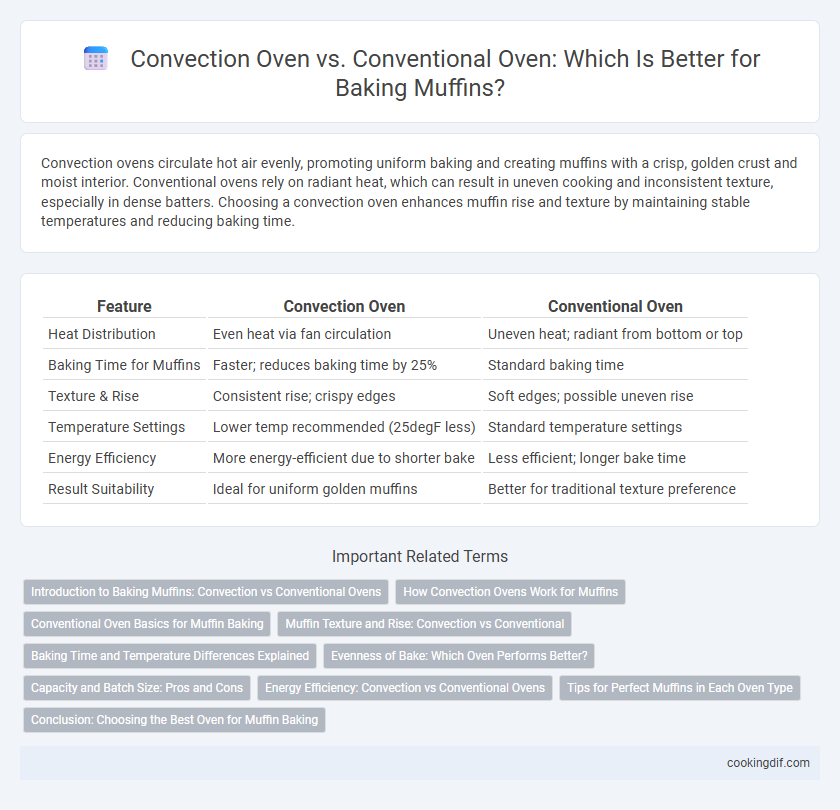Convection ovens circulate hot air evenly, promoting uniform baking and creating muffins with a crisp, golden crust and moist interior. Conventional ovens rely on radiant heat, which can result in uneven cooking and inconsistent texture, especially in dense batters. Choosing a convection oven enhances muffin rise and texture by maintaining stable temperatures and reducing baking time.
Table of Comparison
| Feature | Convection Oven | Conventional Oven |
|---|---|---|
| Heat Distribution | Even heat via fan circulation | Uneven heat; radiant from bottom or top |
| Baking Time for Muffins | Faster; reduces baking time by 25% | Standard baking time |
| Texture & Rise | Consistent rise; crispy edges | Soft edges; possible uneven rise |
| Temperature Settings | Lower temp recommended (25degF less) | Standard temperature settings |
| Energy Efficiency | More energy-efficient due to shorter bake | Less efficient; longer bake time |
| Result Suitability | Ideal for uniform golden muffins | Better for traditional texture preference |
Introduction to Baking Muffins: Convection vs Conventional Ovens
Baking muffins in a convection oven offers faster, more even heat distribution thanks to its fan-assisted airflow, resulting in a uniformly browned crust and moist interior. Conventional ovens rely on radiant heat from heating elements, which can create uneven temperature zones and longer baking times, sometimes causing inconsistent muffin textures. Understanding these differences helps bakers choose the ideal oven type for consistent muffin quality and texture.
How Convection Ovens Work for Muffins
Convection ovens use a fan and exhaust system to circulate hot air evenly around muffins, promoting faster and more uniform baking compared to conventional ovens. This airflow reduces hot spots and helps achieve a consistent rise and golden crust on muffins, enhancing texture and flavor. Baking muffins in a convection oven typically requires lowering the temperature by 25degF and adjusting baking time to prevent overcooking.
Conventional Oven Basics for Muffin Baking
Conventional ovens provide consistent, even heat essential for achieving the perfect muffin rise and texture. The steady radiant heat allows muffins to develop a tender crumb and golden crust without the rapid drying effect common in convection ovens. Understanding the ideal temperature range, typically 350degF to 375degF, ensures muffins bake evenly with a moist interior and well-formed domed tops.
Muffin Texture and Rise: Convection vs Conventional
Convection ovens provide more even heat distribution, resulting in muffins with a consistent rise and a slightly crisper exterior, while conventional ovens often produce a softer, fluffier texture due to gentler heat. The fan in convection ovens accelerates moisture evaporation, which can enhance the muffin's crust but may reduce overall tenderness. For a lighter, airier muffin interior, conventional ovens typically offer better control over rising and moisture retention during baking.
Baking Time and Temperature Differences Explained
Convection ovens bake muffins faster than conventional ovens due to the circulation of hot air, often reducing baking time by 25%. They typically require lowering the baking temperature by 25degF (about 15degC) to prevent overbaking and ensure even cooking. Conventional ovens rely on radiant heat and may produce uneven muffin textures if baking time and temperature are not carefully monitored.
Evenness of Bake: Which Oven Performs Better?
Convection ovens circulate hot air evenly around the muffins, promoting uniform heat distribution that results in consistent rise and golden-brown tops. Conventional ovens rely on radiant heat from heating elements, which can create hot spots and uneven baking, often causing muffins to bake inconsistently with varying textures. For bakers seeking precise and evenly baked muffins, convection ovens typically outperform conventional models in minimizing undercooked centers and overly browned edges.
Capacity and Batch Size: Pros and Cons
Convection ovens offer increased capacity and faster baking times, allowing for larger batch sizes of muffins due to even heat distribution and efficient air circulation. Conventional ovens may have limited space and slower heat transfer, making them less ideal for baking multiple trays simultaneously. However, conventional ovens provide consistent heat that can benefit smaller batches with delicate muffin textures and more controlled rising.
Energy Efficiency: Convection vs Conventional Ovens
Convection ovens use fans to circulate hot air, resulting in faster and more even baking of muffins, which reduces overall energy consumption compared to conventional ovens. Conventional ovens rely on radiant heat and often require longer preheating and baking times, leading to higher energy use. For baking muffins efficiently, convection ovens offer superior energy savings without compromising the texture and rise of the batter.
Tips for Perfect Muffins in Each Oven Type
For perfect muffins in a convection oven, reduce the baking temperature by 25degF and monitor closely to prevent excess browning, as the fan circulates hot air for uniform cooking. In conventional ovens, bake muffins at the recipe's recommended temperature, using the middle rack to ensure even heat distribution and avoid overbaking. Always rotate muffin tins halfway through baking in both oven types to promote consistent texture and rise.
Conclusion: Choosing the Best Oven for Muffin Baking
Convection ovens provide even heat distribution and faster baking times, resulting in muffins with a consistent rise and golden crust, making them ideal for bakers seeking efficiency and uniformity. Conventional ovens, with their steady, radiant heat, are preferred for traditional baking methods that produce a tender crumb and classic texture in muffins. Selecting the best oven depends on balancing speed, texture preference, and baking precision to achieve the desired muffin quality.
Convection oven vs Conventional oven for baking muffins Infographic

 cookingdif.com
cookingdif.com